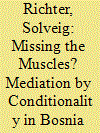| Srl | Item |
| 1 |
ID:
159779


|
|
|
|
|
| Summary/Abstract |
In October 2009, the European Union, in conjunction with the United States, launched a high-level mediation effort in Butmir, Bosnia and Herzegovina, to reform the political structure of the state. Since 2005, the constitution which was included in the Dayton Peace Accord has been widely perceived as dysfunctional. In two negotiation rounds, the EU and the US put a comprehensive proposal on the table and showed strong leverage. However, the talks ended without a tangible result. To explain this failure, a theoretical model is developed based on both mediation and Europeanization literature to explore mediation by conditionality as a type of ‘directive mediation’ in a systematic way. Contrary to the argument that the EU lacked muscle, it is argued that pre-conditions for political conditionality were not fulfilled and strong leverage proved ineffective and counterproductive. These results question conditionality as an effective mediation strategy when state-building is contested between local parties.
|
|
|
|
|
|
|
|
|
|
|
|
|
|
|
|
| 2 |
ID:
159778


|
|
|
|
|
| Summary/Abstract |
This article compares UN and EU mediation practice in the Kosovo-Serbia conflict. It proposes a conceptual framework to analyze mediation effectiveness and its conditions and applies it to the UN-led Kosovo Status Talks in Vienna (2006–2007) and the ongoing EU-facilitated dialogue between Belgrade and Pristina (since 2011). The EU’s relatively high degree of effectiveness compared to the UN effort can be partly explained by the application of a strategy of manipulation, drawing on the EU’s strong leverage vis-à-vis both sides; partly by pointing to the conflict context which has been more favorable to mediation since 2011. At the same time, the analysis reveals that EU mediation has not led to any changes concerning Serbia’s stance toward the recognition of Kosovo’s independence. The continuing non-resolution of the conflict demonstrates the limits of the EU’s manipulative mediation approach and points to a substantial dilemma of EU mediation.
|
|
|
|
|
|
|
|
|
|
|
|
|
|
|
|
| 3 |
ID:
187041


|
|
|
|
|
| Summary/Abstract |
This article examines UN–EU cooperation over peace mediation. It compares their conceptual approaches to peace mediation and the evolution of their institutional capacities, demonstrating that the EU has learned from the UN, while actively supporting the strengthening of UN mediation capacity. The most important difference concerns the embeddedness of mediation in a broader foreign policy agenda in the case of the EU compared to the UN. The article also examines models of EU–UN cooperation in mediation practice. Drawing on an overview of cases of UN–EU cooperation, the article develops a typology of the constellations through which the two organizations have engaged with and supported each other. A case study on the Geneva International Discussions on South Ossetia and Abkhazia investigates the effectiveness of this coordination. The findings point to a high degree of effectiveness, although this has not yet translated into tangible mediation outcomes.
|
|
|
|
|
|
|
|
|
|
|
|
|
|
|
|
| 4 |
ID:
160811


|
|
|
|
|
| Summary/Abstract |
This article explains the creation of the European Institute of Peace (EIP) in May 2014. Combining constructivist insights on policy ideas with a framing approach, it proposes a conceptual framework to analyse the dynamics of interaction between state and non-state actors (NSAs) with regard to formulating new policies and creating new institutions. Focusing on the role of frame entrepreneurs, framing strategies and frame resonance, it argues that the creation of the EIP was a result of framing undertaken by an advocacy coalition in which Sweden and Finland, together with specialized NGOs and individual Members of the European Parliament (MEPs), played the role of frame entrepreneurs. This advocacy coalition managed to convince a number of European states there was a certain gap in the EU’s mediation capacities and that a new institution independent of the EU was needed to address it. The limited degree of frame resonance among the majority of EU member states and their reluctance to join the institute explain why the EIP initiative struggled to receive broad political support.
|
|
|
|
|
|
|
|
|
|
|
|
|
|
|
|